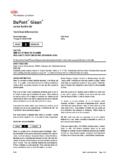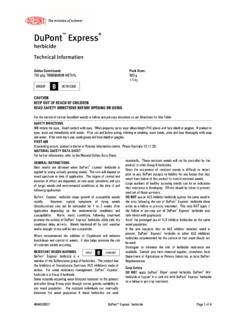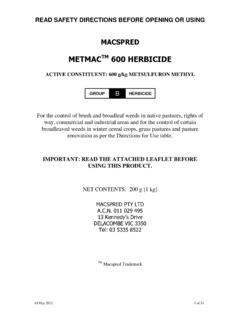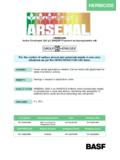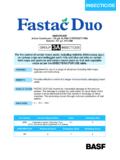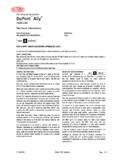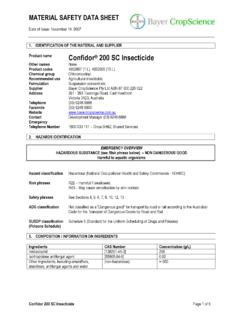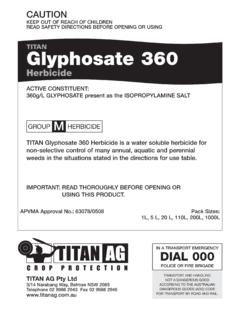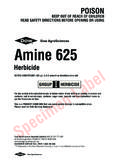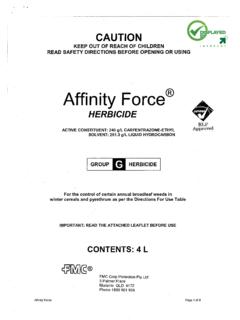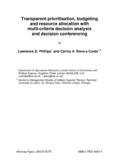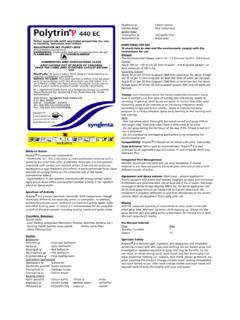Transcription of CAUTION - HerbiGuide
1 CAUTION KEEP OUT OF REACH OF CHILDREN READ SAFETY DIRECTIONS BEFORE OPENING OR USING Roundup Herbicide by Monsanto ACTIVE CONSTITUENT: 360 g/L GLYPHOSATE (present as the isopropylamine salt) GROUP M HERBICIDE Water soluble herbicide for non-selective control of many annual and perennial weeds in certain situations. READ COMPLETE DIRECTIONS FOR USE BEFORE USING THIS PRODUCT. Roundup is a registered trademark of Monsanto Technology LLC, used under licence by Nufarm Australia Limited. DIRECTIONS FOR USE GENERAL WEED CONTROL ALL STATES SITUATION CRITICAL COMMENTS Read Application Checklist before using For general weed control in Domestic areas (Home gardens), Commercial, Industrial and Public Service areas, Agricultural buildings and other farm situations.
2 For specific weeds, brush and woody weeds or unwanted trees, refer to the appropriate Weeds Controlled table. For the control of many grasses and broadleaf weeds. RATE: 10mL per litre of water. Apply when weeds are actively growing. Apply to ensure complete and uniform wetting of foliage. Visible symptoms may take from 3 to 7 days to develop. USE SITUATIONS ALL STATES (except where noted) For rates of application and weeds controlled, see Weeds Controlled tables SITUATION CRITICAL COMMENTS Read Application Checklist before using NON-AGRICULTURAL AREAS Around buildings, Commercial and Industrial areas, Domestic and Public Service areas, Right-of-ways. Roundup does not provide residual weed control.
3 For residual control of annual weeds, Roundup may be tank mixed with certain residual herbicides. See Tank Mixtures/Compatibility. AGRICULTURAL AREAS Roundup may be used for control of annual and perennial weeds as directed, in agricultural land prior to sowing of any edible or non-edible crop, but not prior to transplanting tomato seedlings. AQUATIC AREAS Dry drains and channels, dry margins of dams, lakes and stream situations. DO NOT apply to weeds growing in or over water. DO NOT spray across open bodies of water, and DO NOT allow spray to enter the water. DO NOT allow water to return to dry channels and drains within 4 days of application. FORESTS Roundup may be used prior to establishment of nurseries, for site preparation prior to planting and amongst established trees using a directed or shielded spray, or using selective wiper equipment.
4 DO NOT allow wiper surface to contact any part of the tree. DO NOT allow spray or spray drift to contact foliage or green bark of desirable trees, since severe injury may result. PEANUTS, COTTON, SOYBEANS, SUGARCANE, NAVY BEANS and CHICKPEAS Application using selective equipment QLD, NSW only Wiper Equipment Apply Roundup to weeds growing between crop rows or to weeds growing at least 15 cm above the crop. DO NOT allow wiper to contact crop and ensure operating conditions do not allow solution to drip from applicator since severe injury may result. Refer to Wiper Equipment in the Application section of the label. Shielded Sprayers (Cotton only) Apply Roundup to weeds growing between crop rows using a shielded sprayer.
5 Refer to the Weeds Controlled tables for rates of application. DO NOT apply in crops less than 20cm high. DO NOT allow spray or spray drift to contact any part of the cotton plant as severe injury or destruction may result. APVMA Approval No.: 31393/ 52085 Roundup Herbicide by Monsanto Approved: 25 Mar 2011 Page 2 USE SITUATIONS ALL STATES (except where noted) For rates of application and weeds controlled, see Weeds Controlled tables SITUATION CRITICAL COMMENTS Read Application Checklist before using TREE AND VINE CROPS Avocado, Banana, Blueberries, Citrus fruit, Custard apples, Duboisia, Figs - dessert, Guava, Kiwifruit, Litchi, Mango, Monstera - fruit, Nuts (including Almond, Pecan, Macadamia, Pistachio and Walnut), Olives, Pawpaw, Persimmons, Pome fruit, Raspberries, Stone fruit, Tea, Vineyards.
6 Apply as a directed or shielded spray or using wiper equipment. DO NOT apply as a spray near trees or vines less than 3 years old unless they are effectively shielded from spray and spray drift. DO NOT allow wiper surface to contact any part of the tree, vine or palm. Avoid painting out stumps with this product as injury resulting from root grafting may occur in adjacent trees. Citrus fruit, Nuts, Olives, Pome fruit & Vineyards DO NOT allow spray or spray drift to contact green bark or stems, canes, laterals, suckers, fresh wounds, foliage or fruit. Tea Apply a maximum of 4L/ha by shielded boom or directed off-centre nozzle or by directed handgun or knapsack to avoid application to the crop.
7 All other crops DO NOT allow spray or spray drift to contact any part of the plant including the trunk. CAUTION Where split bark on Kiwifruit and green stems on Pawpaw occur, extreme care is required. For residual control of annual weeds, Roundup may be tank mixed with compatible herbicides which are labelled for use in the above crops. See Tank Mixtures/Compatibility for directions. SUGARCANE RATOON SPRAYOUT For control of sugar cane, ratoon regrowth NSW and QLD only Apply under good growing conditions only to actively growing ratoons 60-120cm tall. DO NOT apply if plants are under stress from low moisture or waterlogging. RATE 4-9L/ha Use the lower rate for suppression or where cultivation is to follow.
8 Use the higher rate for control. PASTURE DIRECTED (SPOT) APPLICATION Roundup is non-selective and may damage or kill any plant in the sprayed area. Re-treatment and/or pasture improvement may be necessary to restrict seedling re-establishment. SELECTIVE APPLICATION See Wiper Equipment. BOOM APPLICATION Roundup may be used to suppress or kill existing pasture species prior to re-seeding or establishment of other crops. Where spot application (spray or wiper) is undertaken, grazing stock need not be removed. CAUTION Certain plants may be naturally toxic to stock. Where known toxic plants are present do not allow stock to graze until complete browning of treated plants has occurred.
9 ONIONS Post-plant, pre-emergence application TAS only For control of annual weeds and suppression of perennial weeds, including Rope Twitch. Apply Roundup at 1-3L/ha post-sowing and at least 7 days before crop is due to emerge. DO NOT apply to emerging onion plants as severe injury will result. Use the lower rate on small, actively growing annual weeds. Increase to the higher rate for larger annual weeds (over 15cm tall) and for suppression of perennial weeds. COTTON PRE-HARVEST For control of Bathurst Burr, Nogoora burr, Winter annual weeds including Sowthistle, Milk thistle and seasonal suppression of Nutgrass NSW and QLD only DO NOT APPLY TO CROPS INTENDED FOR SEED PRODUCTION.
10 Apply alone or in tank mixtures with Dropp* or Harvade*. Apply when at least 60% of bolls are open and immature bolls cannot be easily cut with a sharp knife. Where a leafy crop canopy limits spray coverage, reduced weed control can be expected. For best results under these conditions, delay application until canopy re-opens following initial conditioning treatment. Where control of Nutgrass or Noogoora burr is required, treatments should be applied prior to the onset of frosts. When tank mixed with defoliants, a slightly higher proportion of cotton leaf may be retained, particularly where the higher rate is used. Read and follow all label directions for the tank mix products.
